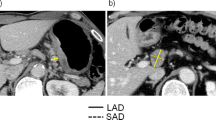Abstract
Purpose
This study was performed to evaluate the diagnostic performance of 64-slice multidetector-row computed tomography (MDCT) for preoperatively detecting the perforation site in patients with gastrointestinal (GI) tract perforations.
Materials and methods
A total of 49 patients with pathologically proven GI tract perforations, who had undergone MDCT were included in this study. The contrast-enhanced axial images (3 mm thick) and multiplanar reformation (MPR) images (3 mm thick) were generated for all the patients. Two radiologists independently reviewed the two sets of MDCT images (axial set: the axial images alone, and combined set: the axial and MPR images) for the detection of the perforation site. The perforation site was considered to be positive according to the direct and indirect findings. The diagnostic accuracy was assessed with a receiver operating characteristic (ROC) analysis. Weighted kappa statistics were used to evaluate the interobserver agreement.
Results
The corresponding values in respect of the first and the second observers for the areas under the ROC curve were 0.984 and 0.966 for the axial set; and 0.998 and 0.973 for the combined set. The differences were not statistically significant between the two data sets for each observer (P > 0.05). Both the observers detected the perforation site in 43 (87.8%) and 40 (81.6%) patients on the axial set, and in 46 (93.9%) and 41 (83.7%) patients on the combined set, respectively. The kappa values between the two observers showed excellent agreement with the two data sets.
Conclusion
64-slice MDCT showed a consistently excellent diagnostic performance for preoperatively determining the perforation site in patients with GI tract perforations, irrespective of the availability of the MPR images.



Similar content being viewed by others
References
Furukawa A, Sakoda M, Yamasaki M, et al. (2005) Gastrointestinal tract perforation: CT diagnosis of presence, site, and cause. Abdom Imaging 30:524–534
Kim SH, Shin SS, Jeong YY, et al. (2009) Gastrointestinal tract perforation: MDCT findings according to the perforation sites. Korean J Radiol 10:63–70
Cho HS, Yoon SE, Park SH, et al. (2009) Distinction between upper and lower gastrointestinal perforation: usefulness of the periportal free air sign on computed tomography. Eur J Radiol 69:108–113
Ghekiere O, Lesnik A, Hoa D, et al. (2007) Value of computed tomography in the diagnosis of the cause of nontraumatic gastrointestinal tract perforation. J Comput Assist Tomogr 31:169–176
Hainaux B, Agneessens E, Bertinotti R, et al. (2006) Accuracy of MDCT in predicting site of gastrointestinal tract perforation. AJR Am J Roentgenol 187:1179–1183
Kim HC, Shin HC, Park SJ, et al. (2004) Traumatic bowel perforation: analysis of CT findings according to the perforation site and the elapsed time since accident. Clin Imaging 28:334–339
Yeung KW, Chang MS, Hsiao CP, Huang JF (2004) CT evaluation of gastrointestinal tract perforation. Clin Imaging 28:329–333
Mangini M, Carrafiello G, Lagana D, et al. (2008) Non-traumatic acute bowel disease: differential diagnosis with 64-row MDCT. Emerg Radiol 15:171–178
Aschoff AJ (2006) MDCT of the abdomen. Eur Radiol 16(Suppl 7):M54–M57
Paulson EK, Jaffe TA, Thomas J, Harris JP, Nelson RC (2004) MDCT of patients with acute abdominal pain: a new perspective using coronal reformations from submillimeter isotropic voxels. AJR Am J Roentgenol 183:899–906
Oguro S, Funabiki T, Hosoda K, et al. (2010) 64-slice multidetector computed tomography evaluation of gastrointestinal tract perforation site: detectability of direct findings in upper and lower GI tract. Eur Radiol 20:1396–1403
Imuta M, Awai K, Nakayama Y, et al. (2007) Multidetector CT findings suggesting a perforation site in the gastrointestinal tract: analysis in surgically confirmed 155 patients. Radiat Med 25:113–118
Ghekiere O, Lesnik A, Millet I, et al. (2007) Direct visualization of perforation sites in patients with a non-traumatic free pneumoperitoneum: added diagnostic value of thin transverse slices and coronal and sagittal reformations for multi-detector CT. Eur Radiol 17:2302–2309
Miki T, Ogata S, Uto M, et al. (2004) Multidetector-row CT findings of colonic perforation: direct visualization of ruptured colonic wall. Abdom Imaging 29:658–662
De Long ER, De Long DM, Clarke-Pearson DL (1988) Comparing the areas under two or more correlated receiver operating characteristic curves: a nonparametric approach. Biometrics 44:837–845
Siu WT, Chau CH, Law BK, et al. (2004) Routine use of laparoscopic repair for perforated peptic ulcer. Br J Surg 91:481–484
Bertleff MJ, Halm JA, Bemelman WA, et al. (2009) Randomized clinical trial of laparoscopic versus open repair of the perforated peptic ulcer: the LAMA Trial. World J Surg 33:1368–1373
Brofman N, Atri M, Hanson JM, et al. (2006) Evaluation of bowel and mesenteric blunt trauma with multidetector CT. Radiographics 26:1119–1131
Iezzi R, Cotroneo AR, Filippone A, et al. (2007) MDCT angiography in abdominal aortic aneurysm treated with endovascular repair: diagnostic impact of slice thickness on detection of endoleaks. AJR Am J Roentgenol 189:1414–1420
Author information
Authors and Affiliations
Corresponding author
Rights and permissions
About this article
Cite this article
Kim, J.W., Shin, S.S., Heo, S.H. et al. The accuracy of 64-slice MDCT for determining the perforation site of the gastrointestinal tract: ROC analysis. Abdom Imaging 36, 503–508 (2011). https://doi.org/10.1007/s00261-010-9660-2
Published:
Issue Date:
DOI: https://doi.org/10.1007/s00261-010-9660-2




